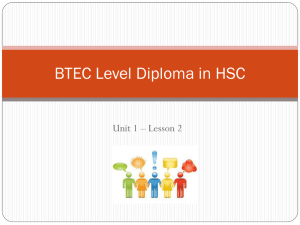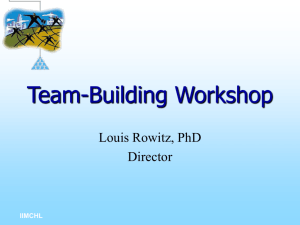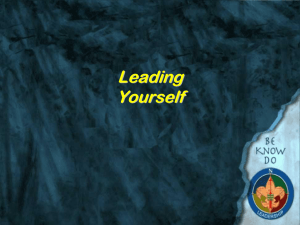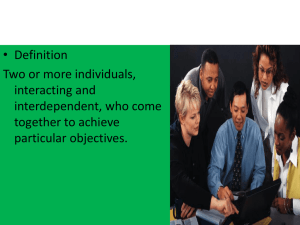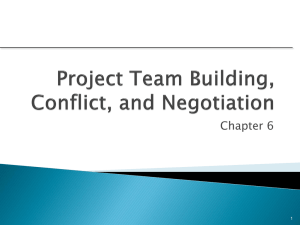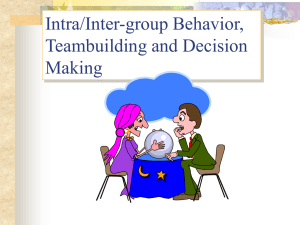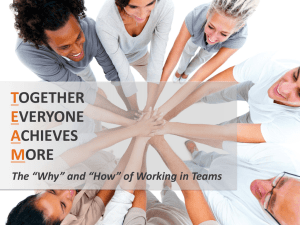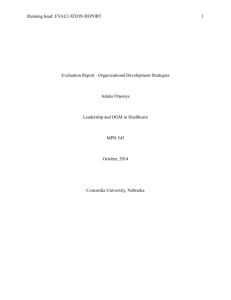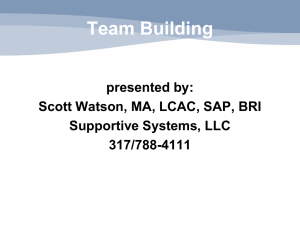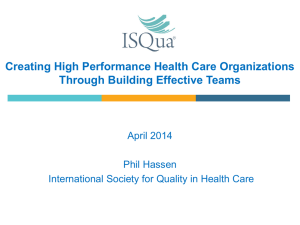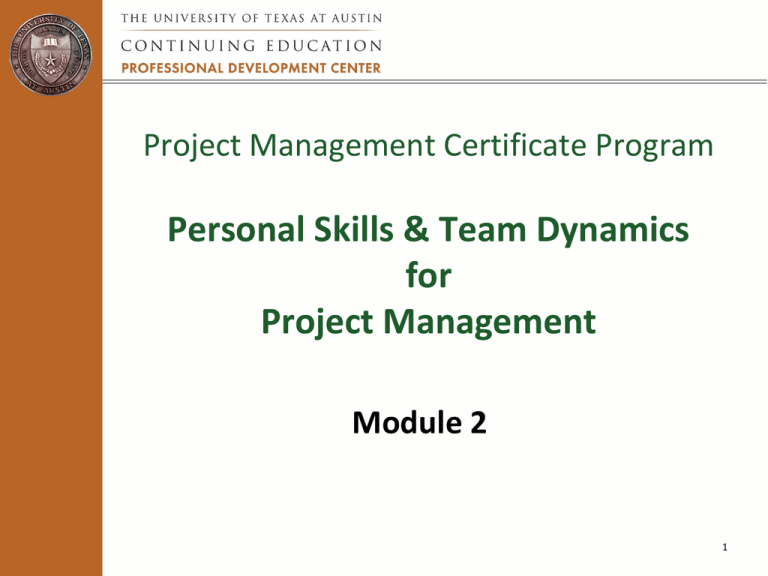
Project Management Certificate Program
Personal Skills & Team Dynamics
for
Project Management
Module 2
1
Today’s Agenda
•
What makes projects fail/succeed?
•
Organizational structure considerations
•
Leadership Skills
•
Conflict management
•
General Management Skills
•
Dealing Effectively with Project Stakeholders
•
Building a Project Team
•
Facilitating Project Team Meetings
2
What makes projects fail/succeed?
3
Why Do Projects Fail?
•
Inadequate resources
•
Inadequate time
•
Inadequate
goals/expectations
•
Disagreement and
confusion within the team
•
Inadequate management
involvement, guidance, &
support
#1 Reason a project fails is lack of Leadership!
What Makes Projects Successful?
•
Team clearly understands the
project outcome
•
Team members are willing and
properly trained
•
Detailed, complete, up-to-date
project plan
•
Adequate resources
•
Realistic project schedule
•
Feasible project scope
What Makes Projects Successful?
•
The team’s personal needs
and priorities are considered
vital
•
PM must have formal and ongoing support of management
and stakeholders
•
PM must be “adaptable”
•
PM must be a great
communicator
•
PM must be “open”
•
PM must be a good leader
What Must Change
Within Organizations?
A
B
C
• Internally driven to
customer driven
(includes quality)
D
• Functionally focused
to process focused
Project 1
Project 2
A
B
C
D
• Management centered
to employee (team)
involvement
Project 3
7
How Organizations Are Changing
• Traditional:
Direct people
• Participatory:
Involve people
• Team leadership:
Build TRUST in
people
8
Remember the Matrix?
Consider Leadership …
Chief Executive
Manager of
Project Managers
Functional
Manager
Functional
Manager
Project
Manager
Staff
Staff
Project
Manager
Staff
Staff
Project
Manager
Staff
Staff
Project Management
9
Leadership Skills
Leadership:
Communicating people's
worth potential so
clearly, that they come to
see it in themselves.
(S Covey)
10
Exercise:
As a group, discuss and list (on a flip chart) some of
the traits you look for in a leader
11
What Makes A Good Project Manager?
Traits:
• Flexibility
• Ambition/energy
• Customer (quality)
focused
• Intelligence
• Decisiveness
• Consciousness of social
environment
• Willingness to take
responsibility
• Creativity
• Persistence
• Tolerance toward
ambiguity/stress
Skills
• Conceptual
• Social
• Diplomacy
• Communication
• Organizational
(administrative/tim
e management)
You must live it—not
just expect it
from others!
12
Human Resource Skills for the Project Manager. Vol 2
Vijay Verma, pg 212-213
HIGH
Situational Leadership Styles
SUPPORTING
S
U
P
P
O
R
T
I
V
E
B
E
H
A
V
I
O
R
LOW
Facilitates and
supports efforts of
subordinates toward
tasks,
accomplishment, and
shares decisionmaking
responsibilities
DELEGATING
Turns over
responsibility for
decision-making and
problem solving to
subordinates
Directive Behavior
PMI: Steppin’ Into Leadership.
COACHING
Continues to direct and
closely supervise task
accomplishment, but
also explains
decisions, solicits
suggestions, and
supports progress
DIRECTING
Provides specific
instructions and
closely supervises task
accomplishment
HIGH
13
Leading Project Teams
Team Building Activities / Improving Team Performance
• Involving non-management level in planning
• Establishing ground rules for dealing
with conflict (see sample meeting agenda)
• Conduct team building exercises
• Obtain team member commitment—regularly
• Communicate, communicate, communicate
Team Spirit: “A readiness to work with others
toward a common goal.”
14
Leading Project Teams
Team Building Activities / Improving Team Performance
• Reward and recognition systems
– Must link performance with goals
– Should be project-oriented--not
just organization
– Should consider environmental and
cultural differences
• Logos
• Collocation (“tight matrix”)
– Team is in close proximity (WAR Room)
• Training
– Enhancing skills, knowledge,
and capabilities
– Formal and informal
15
Leading Project Team Meetings
(Group Dynamics)
1. Group
2. Goal
3. Process
4. Environment
(Chemistry)
(Achievability)
(Climate)
“Who”
“What”
(Appropriateness)
“How”
“Where”
S.M.A.R.T.
* SMES
*Decision
makers
* Scribe
* Valuable
input
* Stakeholders
* Specific
* Measurable
* Achievable
(Agreed upon)
* Realistic
* Timely
* Information
Sharing
* Information
Processing
* Problem
Solving
* Process
Improvement
Phys.
Tech.
Emotional
Size
Chairs
Tables
Temp
Lights
Noise
A/V
Boards
Handouts
Flip Chart
Markers
Computer
Affected
by
Physical
and
Technical
16
Leadership And The
Project Management Life Cycle
Visionary
Empowerment
Listener
Analytical
Change master
Decision maker
Work/fun
Trustworthiness
Team
Synergy
Team builder
Power and
influence
Integrator
Administrator
Executing
Level
of
Activity
Planning
Closing
Initiating
Controlling
Time
17
Conflict Resolution
18
Team Stages
Mourning/
Adjourning
Performing
Forming
Storming
Norming
Productivity
+
0
Conflict
-
Forming
Storming
Norming
Performing
Adjourning
19
Conflict
• “When two or more people’s
differences escalate to a
level that negatively affects
(or may affect) productivity,
quality, service, morale, or
working relationships.”
More Change, More People, More Conflict...
20
Views on Conflict
Traditional View of Conflict:
- Caused by troublemakers
- Bad
- Should be avoided
Current View of Conflict:
- Inevitable, often beneficial
- Natural result of change
- Can be managed
- Use the differences!
21
Conflict Management
• Definition:
“A process by which the project manager uses
appropriate managerial techniques to deal with
inevitable disagreements - both technical and personal
- that develop among those working toward project
accomplishment.”
• Your Goal: Manage and prevent conflicts
– Minimize negative impact on project
– Harvest the benefits
22
* Sources of Conflict
Sources of Conflict
Definitions
(priority order in
*INITIATION)
#1 Project Priorities
View of project participants differ over
sequence of activities and tasks.
#2 Administrative
Procedures
Managerial and administration oriented
conflicts over how the project will be
managed
#3 Technical Opinions &
Performance Trade-offs
Disagreements over technical issues,
performance specifications, technical
trade-offs
#4 Human Resources
Conflicts about staffing a project team with
personnel from other areas
#5 Cost
Conflict over cost estimates from support
areas regarding work breakdown structures
#6 Schedule
Disagreements about the timing,
sequencing and scheduling of projectrelated tasks
#7 Personality
Disagreements on interpersonal issues
23
Team Conflict
Sources in order (overall project)
1.
2.
3.
4.
5.
6.
7.
Schedules
Project priorities--different
visions/goals related to
activities/tasks
Resources
Disagreements over technical issues
and performance trade-offs
(vagueness)
“Administrivia”
Cost
Personality
24
Ways to Resolve a Conflict (PMI)
• Avoiding/Withdrawing – Ignoring or retreating from
the problem
• Smoothing - De-emphasize differences and emphasize
commonalities – Friendly
• Compromising - Find solutions that bring some
degree of satisfaction to parties - Neither wins
• Forcing - Exert one's view at expense of another party
• Problem Solving - Address disagreement directly.
Select most appropriate alternative
25
Conflict Management
(Options)
Assertive
Forcing/Competing
(Power, “My way…”
Win-Lose)
Problem Solving,
Collaborating/Confronting
(Consensus, Win-Win)
Compromising
(Bargaining, Partial Agreement
Lose-Lose)
Unassertive
Avoiding/Withdrawal
(Passive, retreating
Lose-Lose)
Uncooperative
Smoothing/Accommodating
(Friendly
Lose-Lose)
Cooperative
26
How To Approach Conflict Mgmt
1. Prepare for Conflict
– Expect conflict.
– Plan ahead to handle conflict. (Communicate how
the team will handle conflict.)
2. Face the Conflict
– Serve as a lightning rod (Deal with it - don’t take
it personally.)
– Surface the real issues.
3. Resolve the Conflict
– Look for win-win alternatives.
– Cut your losses when necessary.
27
Conflict Management
(...Ask Yourself)
• What is the real source of the conflict?
• Are you diplomatic enough to handle it yourself?
• Can it be worked out with a meeting of the members in
conflict?
• Will it go away by itself?
Conflict Management
(Confronting/Problem Solving)
•
•
•
•
•
•
•
•
Use a direct approach
Pinpoint the problem
Develop alternatives
Objectively resolve (take the
emotion out)
Take the time
Maintain open dialogue
Get to a final solution
Stay Win-Win
28
Conflict Resolution
• Preventative measures
– Meeting ground rules
– Expectations
– Communications
– Consensus
29
Be Versatile
(Backup Behavior)
The Versatile Salesperson, Roger Wenschlag, Wilson Learning Company
Conflict/Backup Behavior
When discussions break down….
Draw them
out;
listen clarify,
problem
solve,
ask.
Let them
vent;
listen,
clarify,
problem
solve,
ask.
30
Exercise
How Do You Handle Conflict?
31
General Management Skills
32
Exercise: Develop Team Operating
Guidelines
•
•
•
Goal:
To develop Team Operating Guidelines that reflect
behaviors important to your team.
Benefits:
– Establishes team expectations
– Creates process before unwanted behavior
occurs
– Expedites Forming-Storming-Norming stages
Use Exercise handout
33
Five Key General Management
Skills
#1 Communicating
• Getting information to the right people at the right
time
#2 Negotiating
• Reaching agreement
#3 Problem Solving
• Problem definition and decision making
#4 Influencing the Organization
• Getting things done (without formal authority)
#5 Leading (covered in previous session)
• Establishing direction, aligning people, motivating &
inspiring
34
Communication
• Definition:
“Involves the exchange of information.”
(understanding)
• Responsibilities
– Sender - makes sure the information is clear,
unambiguous, and complete.
– Receiver - makes sure the information is received
in entirety and understood correctly.
35
How Much Time Does a Project
Manager Spend Communicating?
• Project managers spend roughly 75 - 90% of their
working hours speaking or listening.
“One's effectiveness is
determined by one's
ability to reach others
through the spoken or
written word ... perhaps
the most important of all
skills.”
-- Peter Drucker
Reading 10%
Speaking
30%
Writing 10%
Other 5%
75%
Listening
45%
36
Dimensions of Communication
• Written and oral, listening and speaking
• Internal (within the project) and external (customer,
media, public)
• Formal and informal
• Vertical (upper management, subordinates) and
horizontal (peer departments)
37
Communication
Model
Field of Experience
Idea
Encoding
Message
Initiated
Encoder/
Sender
Meaning
Field of Experience
Filters:
Distraction
Perceptual/
Cultural
Interference
Differences
Idea
Decoder/
Receiver
Shared
Experience
Decoding
Filters:
Distraction
Perceptual/
Cultural
Differences
Encoding
Meaning
Decoding
Message
Interference
Feedback
Sources of Perceptual Differences: Words, culture, judgments, values, emotions, personalities
TRANSFER UNDERSTANDING!
38
Feedback Guidelines
• Feedback should be:
– Timely – Given as soon as possible
– Specific and descriptive – Don’t be general
– Non-evaluative – Don’t get personal
– Goal Oriented – Value of a change for the person
– Limited – Don’t overload the person
– Two-way – Allow the other person time to give
observations
39
Communication Channels
Formula
(n = # people on project):
n (n-1)
2
Number of channels for:
• 6 people = 15
• 30 people = 435
40
Exercise:
Your project team has just gone from
8 to 12 members. How many more
channels of communication have been
added?
41
Influencing the Organization
• Definition:
– “Ability to “get things done.”
• Requires an understanding of:
– Formal and informal organizational structures
– Power and politics
– Conflict management
42
Negotiating
• Definition:
“Conferring with others to come to terms with them or
reach an agreement.”
• Agreements may be negotiated:
– Directly between the parties
– With assistance
• Mediation – neutral third party helps disputants
work out their own solution to the conflict
• Arbitration – neutral third party imposes a
binding solution on the parties
43
Negotiating
PMBOK, Appendix G
• “Negotiating involves
conferring with others to
come to terms with them or
reach an agreement.”
• May focus on:
– Scope, cost, and schedule
– Changes to scope, cost, or
schedule
– Contract terms and
conditions
– Assignments
– Resources
44
When is Negotiation Used?
• All the time! Key skill to manage a project through the
actions of others.
• Some examples are:
– Scope, cost, and schedule objectives & changes
– Contract terms and conditions
– Resource allocation (staff may be pre-assigned
within project charter)
45
* Negotiation Spectrum
Cooperative
Competitive
CONFLICT SPECTRUM
Objective:
WIN / WIN
WIN / LOSE
Style:
Soft
Hard
Control:
More
Less
Examples:
Principled
Negotiation
Mediation
ArbitrationTrial
•
Roger Fisher & William Ury, Getting to Yes, New York,
Penguin Books, 1991
•
William Ury, Getting Past No, New York, Penguin Books,
1993
War
46
Negotiating
Soft
• Participants: Friends
• Goal: Agreement
• Make concessions to
cultivate relationship
• Be soft (on the
people/problem)
• Trust others
• Change position often
• Make offers
• Disclose bottom line
vs.
Hard
• Participants:
Adversaries
• Goal: Victory
• Demand concessions as a
condition of the
relationship
• Be hard (on the people/
problem)
• Distrust others
• Dig in to position
• Make threats
• Mislead as to your bottom
line
“Getting To Yes”
Roger Fisher and William Ury
47
Multi-Cultural Impact on
Negotiations
• Definition:
“Culture is the distinctive way a group of people linked
by geographic location, religion, and/or ethnic beliefs
lead their lives.”
• Project manager's own cultural bias affects
negotiations
– Self-reference criterion
– Culture shock
48
Dealing Effectively with Project
Stakeholders
49
Project Stakeholders
• Definition:
“Individuals and organizations that are actively
involved in the project, or whose interests may be
positively or negatively affected as a result of project
execution or project completion.”
50
Identifying Stakeholders
51
•http://www.google.com/images?q=stakeholders+funny+project+management&hl=en&gbv=2&tbs=isch:1&sa=N&start=84&ndsp=21
Dealing with Stakeholders
52
Who Are They?
Examples:
Customers
Project sponsor
Project Manager
Project Management
team
Participating
organization
End Users
Founders and owners
Suppliers and
contractors
Government agencies
Interest groups
Private citizens
Internal and external
Team members and
their families
Media outlets
Individual citizens
Temporary or
permanent lobbying
organizations
Society at large
53
Project Stakeholders –
Team Responsibilities
• Project management team must:
– Identify all the stakeholders (often difficult)
– Determine their requirements
– Manage and influence those requirements to ensure
a successful project
54
Managing Their Expectations
• Stakeholders often have very different objectives that
come into conflict
• Generally, differences among stakeholders should be
resolved in favor of the customer
• Benefits of stakeholder involvement - Improves:
– Probability of satisfying customer requirements
– Buy-in or shared ownership of project
55
Building A Project Team
56
Team Development - Critical for
Project Success
• Definition:
“Developing individual and group competencies to
enhance project performance.”
• Includes enhancing the ability of:
– Stakeholders to contribute as individuals
– Team to function as a team
• Challenges
– Getting diverse people to work together effectively
– Must be a simple, practical method
– Must be integrated into every day activities!
57
Team Development Stages
Stage
Forming
Storming
Norming
Performing
Adjourning
Activity
Members find out:
what they will be doing,
the styles of acceptable leadership, and
possible kinds of interpersonal/task relationships
Members begin resisting the group’s influence
There is conflict over competing approaches to reaching the
group’s goals
Resistance is overcome as the group:
establishes its rules and standards,
develops intragroup cohesiveness, and
delineates task standards and expectations
The group is ready to focus attention on task
accomplishment
Issues of interpersonal relations, member status, and
division of tasks are settled
The group has fulfilled its purpose, or died
Characterized by
courtesy
confusion
caution
commonality
tension
criticism
confrontation
cooperation
collaboration
cohesion
commitment
challenge
creativity
group consciousness
consideration of members
compromise
communication
consensus
58
closure
Mourning/
Adjourning
Performing
Forming
Storming
Norming
Productivity
+
0
-
Forming
Storming
Norming
Performing
Adjourning
59
PMBOK’s Team Development
Process
Inputs
• Project staff
• Project plan
• Staffing
management
plan
• Performance
reports
• External
feedback
Tools and
Techniques
Team-building
activities
• General
management
skills
• Reward and
recognition
systems
• Collocation
• Training
Outputs
• Performance
improvements
• Input to
performance
appraisals
60
Team-Building Activities
• Definition:
“Include management and individual actions taken
specifically and primarily to improve team
performance.”
• Activities can occur during:
– Daily activities (ex: in a status meeting)
– Specially designed experiences (ex: off-site)
61
Team-Building Activities (cont’d)
• Characteristics of a good team:
– Be interdependent
– Have a reason to work together
– Be committed to working together
– Be accountable as a functioning unit
– Have a moderate level of competition and conflict
– Ensure all going in same direction and recognize
same goals and objectives
– Obtain consensus on project goals and objectives
62
Team-Building Benefits
•
•
•
•
•
•
•
People come together to solve mutual problems
Team members become motivated
Conflicts are resolved
Creativity is stimulated
Team acquires a collective strength
Job satisfaction increases
Synergy develops
63
Team-Building - Problem
Indicators
•
•
•
•
•
•
•
•
•
•
Frustration
Conflict and unhealthy competition
Unproductive meetings
Lack of trust or confidence in project manager
Excessive "wheel-spinning"
Performance degrades with no known cause
Decisions are made but not implemented
Detrimental surprises
Team members are unresponsive or apathetic
Team members withdraw into their own areas of
responsibility, avoiding cooperation with the team
64
Team-Building Limitations
• Cannot fix a project which:
– Has a faulty concept
– Lacks management support
• Cannot rectify inept team members or project manager
• Difficult to fix an inherited project that is already in
trouble
65
Team-Building Skills, Tools, and
Diversity
• Skills and tools enable the project manager to handle
diversity – “the quality of being different.”
– Ethnic beliefs
– Religion
– Country cultures
– Social organization
– Political life
– Aesthetics
– Language
– Family background
– Corporate cultures
– Education
– Physical capabilities
– Learning styles
– Psychological Type
– Age
– Sex
– Race
66
Facilitating Project Team Meetings
67
Exercise
•
•
•
•
•
•
•
Quiet Member(s)
Dominator(s) / Rambler(s)
Cynic(s) / Sniper(s)
Interrupter(s) / Side Conversationalist(s)
Joker(s)
Sleeper
•Discuss how you would
Others?
handle each of the disruptive
behaviors in a project team
meeting with your group
•Share with the class
68
Brainstorming Guidelines
• Goal:
To develop as many options as possible
– Be creative (not necessarily realistic!)
– Build on the ideas of others
– Don’t evaluate options until later
– Don’t debate
69
Problem Solving
Evaluate
Solution
6
Implement
Solution
5
Identify &
Select
Problem
1
Analyze
Problem
Problem
Solving
Process
Select &
Plan Solution
2
Generate
Potential
Solutions
3
4
70
Problem Solving – As a Team
• Why solve problems as a team?
– Improves effectiveness of decisions
– Taps creativity of employees
– Creates greater ownership
– Fosters teamwork
– Establishes a systematic and standard approach to
problem solving
71
Consensus Building
(Decision Model)
COMMAND
I
N
D
I
V
I
D
U
A
L
CONSULTATIVE
CONSENSUS
General Agreement Where
Everyone Expresses Their
Support For A Decision
Time
Constraints
Better
Acceptance
Exchange all ideas
Use effective listening skills
Be open-minded to other people’s ideas/opinions
Discuss pro’s & con’s of each idea. Test to see if
consensus is achieved
5. Use problem solving techniques if needed
G
R
O
U
P
1.
2.
3.
4.
72
Facilitation
• Definition:
“A process in which a person, who is acceptable to all
(a third-party neutral) and has no decision-making
authority, helps a group improve the way it identifies
and solves problems, and makes decisions.”
Facilitator focuses on ?
73
Facilitation Benefits
• Systematic way of handling group decision-making
• More participation and commitment
• More comprehensive solutions
• Improves attitude and morale
74
Use a Facilitation Process
1.
2.
3.
Before the meeting
a. Assess the situation and design the agenda
b. Get feedback and refine the agenda
c. Prepare the room
During the meeting
a. Conduct the meeting
• Use Group Process skills
• Use Facilitator role skills
b. Get closure
After the meeting
a. Document the results for the team from the
flipcharts (or provide flipcharts to team to
document)
b. Follow up with team for feedback
75
Facilitation - Group Process Skills
Problem solving
Communication
Decision making
Conflict management
Note: Top two group
facilitation skills are
also Key General
Management Skills
Boundary management
76
Facilitating Project Team Meetings
(Roles and Responsibilities)
• Leader
• Participants
• Facilitator
• Presenter
• Timekeeper
• Scribe
77
Facilitator Role Skills
•
•
•
•
•
•
•
•
•
•
•
•
•
•
•
•
Separate process from content
Stay neutral on content
Encourage participation
Keep group “on topic”
Help members adhere to their ground rules
Ask open-ended questions
“Active” listen
Paraphrase to clarify
Capture ideas succinctly on flip charts
Intervene if there are problems
Maintain high energy level
Set a positive tone
Summarize status and concepts
Be flexible
Be firm
Be unobtrusive
78
Exercise: Develop Team Operating
Guidelines
•
•
•
Goal:
To develop Team Operating Guidelines that reflect
behaviors important to your team.
Benefits:
– Establishes team expectations
– Creates process before unwanted behavior
occurs
– Expedites Forming-Storming-Norming stages
Use Exercise handout
79
A Useful Tool:
Team Responsibility Matrix
• When roles/responsibilities for work products are
unclear or a source of conflict
• Typical Roles:
A
Responsibility
Assignment
Matrix
Who
L
S
C
R
What
Role
Approval Approves the item as complete ( L approves if not indicated)
Lead Has final responsibility for producing the item
Secondary Is the lead person's backup for the item, else is a C and R
Contributor Materially contributes to the item (includes R)
Reviewer Has reviewer duties only for the item
None Is not expected to participate in producing or approving the item
80
Summary
What makes projects fail/succeed?
Organizational structure considerations
Leadership Skills
Conflict management
General Management Skills
Dealing Effectively with Project Stakeholders
Building a Project Team
Facilitating Project Team Meetings
81

